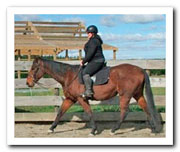Ted - Lessons Learned from a Photic Head Flicker.
Ted had been a fabulous horse for Alice. A real dude who was good to ride on the roads and generally a fun horse to own.
But back in Autumn 08 there’d been a change, he’d started flicking his head up and down when ridden and even thrown in some nasty bucks. He had become a ‘head-flicker’.
All manner of expensive investigations were made and treatments tried but Ted only got worse. To the point he was dangerous to be around as he would suddenly start leaping around trying to box his nose with his front feet.
Head Flicking is an exasperating condition and many horses are destroyed needlessly because of it. If your horse is Head Flicking take a look at what he is eating before doing anything else!
The Problem
It was obvious he was also photophobic as he was desperate to seek shade and became extremely agitated when brought out into the light.

In the photo of him above, you can see by his expression he is in pain and they do behave exactly like they have a bad migraine head-ache.
Ted became so bad he threw Alice off - this is not a result of 'bad behaviour' but a clear sign that the horse is in pain and can not cope!
The Treatment Starts - and Stops
As Alice didn’t feel safe to handle him we took him into 'rehab’ and put him in the roundpen where there was no green.
This is the key to rapid recovery.
It took 8 weeks living in the round-pen on ‘good grass’ hay (NO clover, NO lucerne) with a feed of beet, oaten chaff, barley, Alleviate and Premium Horse Minerals. We did not know to feed extra salt back then.
Eventually, some ‘good , long, mature grass’ grazing was found and, after her parents went to the trouble of spraying out the clover in this paddock, Ted went back to Alice.
Things went OK for awhile but by autumn he had started flicking again.
I now realise this was because he had eaten all the grass down short meaning it was in the minerally imbalanced vegetative state which set off the trigeminal nerve inflammation and head-flicking again.
Back to us he came where down the road I had found some mature cocksfoot grazing for him and another TB.
This was autumn 09 and the same scenario happened. He was fine for a few weeks, eating the tops off the mature grass but as soon as the grass was grazed and short, with the autumn rain there was Ted standing over the water trough plunging his head in and out, or standing with his head stuffed in the hedge. He had reverted again.
A Breakthrough is Revealed!
It was then that correspondence with Dr Swerczek,  veterinarian from Kentucky, USA revealed that grass in it’s vegetative state, especially under certain weather conditions becomes very high in potassium and nitrates, and it does not become correspondingly high in sodium.
veterinarian from Kentucky, USA revealed that grass in it’s vegetative state, especially under certain weather conditions becomes very high in potassium and nitrates, and it does not become correspondingly high in sodium.
Based on his advice we started feeding a lot more salt to all our horses, Ted included.
From May 09, all through the winter Ted was fed approximately 80gms of salt daily. He was 16hh and about 500kgs.
This did not stop his head-flicking straight away but by the time spring came along it had clearly ‘kicked in’ as there was no sign of flicking all spring.
This was truly amazing as whilst he wasn’t out on lush, spring pasture and he was fed half a bale of hay per day, there was green in his paddock which would previously have triggered bad flicking episodes.

Alice riding a MUCH happier Ted!
There was NO flicking all spring after 7 months on extra salt.
NB Salt licks are completely inadequate, the salt needs to be mixed in a feed.
Read about adding extra salt...
 Calm Healthy Horses
Calm Healthy Horses